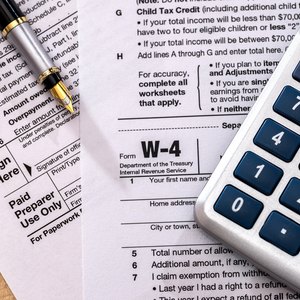
Getting one big paycheck at the end of the month or at the beginning of the month has its advantages. You can pay bills according to your monthly budget all at once and be done with it. Your employer withholds more money for taxes each payday to compensate for the longer pay period, but it's allocated over each week.
A monthly paycheck doesn't affect your overall tax liability or how you prepare your tax return. However, you do have to ensure that enough taxes are withheld from each paycheck.
It's the Same Tax Liability
Your earnings at the end of the year are the same whether they're divided into 12 monthly paychecks, 52 weekly paychecks or some other arrangement. Your annual income is what determines how much you owe in taxes, so this means the number of pay periods doesn't affect your tax liability.
Your monthly pay would be $3,250 if you were paid a salary of $750 per week and your employer decided to change over to a monthly pay schedule. This works out to $39,000 for the year either way, and that's the amount used to compute your tax liability.
Setting Up Your W-4
You'll state your contact information, Social Security number and tax filing status when you fill out the W-4 form your employer gives you. You can also use this form to provide information about dependents and income you receive from other jobs.
Your employer then uses Form W-4 to determine how much to subtract from your gross pay before calculating your federal income tax. This shouldn't concern you if you're paid monthly because the amount of a withholding allowance is adjusted for the length of the pay period.
The IRS redesigned Form W-4 in 2020 after personal exemptions were eliminated from the tax code. The good news here is that the instructions for completing the form are now clearer and much easier to navigate so you can address numerous issues that will affect your withholding and take-home pay. The IRS also publishes FAQs regarding the W-4 process.
Income Tax Calculation
Your annual earnings are divided according to the number of paychecks received. In practice, most employers use percentage tables published by the IRS.
Suppose you earn $2,600 per month (or $31,200 a year) over and above your standard deduction in 2023 and you're single with no dependents. The first $11,000 of that would be subject to the 10 percent tax rate according to 2023 tax brackets. That works out to 10 percent of your income up to $1,100 a year, or $91.66 a month. The balance of your income ($20,200 annually or $1,683.33 a month) would be taxed at the rate of 12 percent: $2,424 a year, or $202 a month. Your total tax liability would therefore be $3,524 a year or about $293 a month.
The same equation would apply if you were paid weekly, but your annual pay and tax bracket percentages would be divided by 52 weeks in the year rather than 12 months. You'd earn $600 a week, of which $211.53 would be taxed at 10 percent ($21.15) and $388.47 would be taxed at 12 percent ($46.61). That works out to $67.76 in taxes withheld a week, or $3,523.52 a year – still $293 a month.
Tips
Keep in mind that this example and the calculations are based on your pay over and above the standard deduction or itemized deductions you'll claim when you file your tax return. You have the choice between itemizing or claiming the standard deduction for your filing status, and you might possibly qualify to claim some adjustments to income as well. These choices and tax breaks are reflected in the information you provide on your Form W-4, and your withholding is based on this information.
The same equation would apply if you’re paid biweekly, bimonthly or semimonthly. Just use the applicable number of biweekly pay periods in a year.
Tax brackets can shift slightly from year to year to keep pace with inflation, but the difference is usually just nominal dollars. The IRS publishes inflation adjustments for the upcoming year each year in October.
Spreading Tax Through the Year
The system of payroll tax is designed so that you've paid most of your taxes by year’s end, and you won’t owe a big lump sum. But it doesn't take factors like self-employment income or investment earnings into account, money from which taxes aren't withheld on your behalf. Luckily, the IRS provides a tax withholding estimator on its website. You can get a handle on just how much withholding you should cover from these sources.
You can then save money in advance to cover these taxes when you file your return, or you can ask your employer to withhold extra amounts from your paycheck to cover that additional income based on the same tax brackets. You can make payments online in advance of filing on the IRS website, withdrawing them from your bank account or checking account or charging them to a credit card or debit card. However, the credit card processor will most likely charge you a small fee.
Some Words of Warning
This math applies only to income tax. Your employer will also withhold FICA taxes (Social Security and Medicare) from your pay. You’ll want to factor these into your calculations for your take-home pay as well so you can accommodate the appropriate amount of money in your cash flow and monthly budget.
All these withholdings should appear on your pay stubs. You’ll especially want to account for them if you live paycheck to paycheck.
The math also assumes that you earn the same amount each week or month, but you may be an hourly employee. Just adjust for the number of hours you normally work in a week.
References
Writer Bio
This article was written by PocketSense staff. If you have any questions, please reach out to us on our contact us page.
